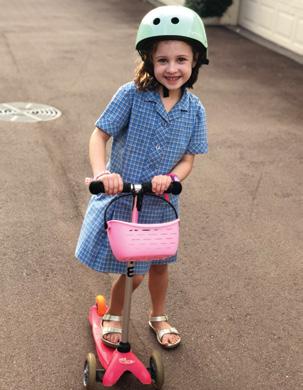
4 minute read
Young urban planners
CHILDREN HAVE AN IMPORTANT PART TO PLAY IN THE WAY FUTURE CITIES ARE DESIGNED
Should children have a say in the way future cities are designed?
Advertisement
We understand from research that the majority of children grow up in urban areas. But has anyone ever considered asking them how they imagine the ideal urban environment for growing up healthy and staying socially connected?
A study from New Zealand’s University of Otago did just that. Not only did the study determine that children have a great deal to contribute to urban planning debates, but they are intuitive urban planners who are more than capable about thinking wholistically about what their community needs to function well.
One part of the study saw preschool children use picture tiles to map their ideal community by selecting facilities and services, keeping it safe, healthy and fun.
Another part of the study involved the children taking research teams around their neighbourhoods to provide insights into what they liked and didn’t like about their local area.
The findings showed that children considered their own needs as well as older people when mapping their ideal community. They asked for health services and facilities that stimulate mind and body, such as libraries, natural environments and gathering places.
Results were interesting. Nearly 80% listed playgrounds as important, 66% included a supermarket in their design, 59% included a hospital, 56% included police cars, 48% a fire engine and 41% a coffee shop.
Streetlights, pedestrian crossings and traffic lights were considered essential safety infrastructure within these communities.
The study found that children not only created child-friendly cities, but carfull ones that work for everyone, including animals and plants. They created cities with physical and social elements designed to “make people happy”.
We asked a few of our own budding urban planners about what makes their community so special. It certainly made for very interesting dinner table conversation
Miles, aged 11
Already a budding urban planner in the making, Lego master Miles already enjoys designing and creating his own communities.
According to Miles, his ideal Lego community has all the essentials you would need.
His community would include a school, dessert bar, variety of restaurants, an Apple store, banks, barber and hairdresser, supermarkets, car dealership, sporting fields and shoes and clothing stores.
Miles lives with his older sister and is a promising young goalkeeper for his local football club. He ranks very highly the importance of having sporting fields within his community, where he can develop his skills, meet with friends and to play.
Interestingly, his car dealership of choice was Ferrari. Only the best for our Miles!
Amy, aged 6
Amy lives with her mum and dog, Louis, in a townhouse community. After school and on weekends Amy likes to ride her scooter and play with her friends within her community.
When asked what she considers to be important within her community, ever the fantasist, Amy dreamt her ideal ‘make believe’ community would have its very own forever rainbow for her and her friends to climb up and run along looking for unicorns.
In comparison, Amy came up with a priority list for her ‘real’ community. This included enjoyable and useful amenities and, not surprisingly, at the top of her list was a park with a playground, a swimming pool (which she preferred over a river or beach), an ice cream shop or a cafe that serves ice cream, and somewhere safe for her to ride her scooter or bike.

Emma, aged 10
Emma lives with her two younger sisters and leads an active lifestyle. She has taken swimming and dancing lessons since she was a toddler, and these two sports consume her afternoons with training. Having access to facilities and open space for exercise is rated very high on her must-have community list.
Ideally Emma would love to see a 50m pool within her community for squad training. As a dancer, she loves the thought of an underground dance studio – a secret dance society specifically for young dancers, and a choice of different restaurants but they must include Thai and Chinese.
Being shopping conscious, Emma says she needs a shopping centre to buy clothes, shoes and food, with cafes, an amusement centre and tenpin bowling alley for entertainment.

Ryan, aged 6
Always thinking of the environment, Ryan would like to see more open park spaces for playing football and riding bikes and scooters. He values the beauty of traditional shrubbery and recently completed his very own Lego project to create a bonsai tree.

Sophie, aged 8
A common thread from our youngsters is how important they rate their local community space for recreation, exercise and socialising.
Sophie is a young athlete who loves to exert her energy each day after school. She trains in tumbling, a form of gymnastics, and is currently coached by Australian representatives in this field. Her career in this sport is looking bright.
Sophie would like to her community to house a large air track (“a big, long bouncy track for tumbling”), a trampolining centre, and a hospital and ambulance station to help with any injuries or sickness.
A big park with swings and somewhere to walk and play with her dog, Sarge, is a priority. So is a cafeteria, an indoor disco/party area, a public library, toy room to meet with friends to play, school, and an amusement/gaming centre for entertainment.
Without the use of picture tiles, our own young experts had similar views as those in the study. They genuinely cared for their local environment and designed spaces to fulfill their physical and mental wellbeing.
Children have a great deal to offer and it would pay to have their young voices heard.
Like Whitney, we too believe the children are our future.








